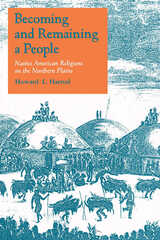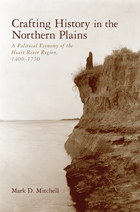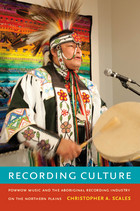3 books about Northern Plains

Becoming and Remaining a People
Native American Religions on the Northern Plains
Howard L. Harrod
University of Arizona Press, 1995
The power of religion to preserve individual and group identity is perhaps nowhere more evident than among Native American peoples. In Becoming and Remaining a People, Howard Harrod shows how the oral traditions and ritual practices of Northern Plains Indians developed, how they were transformed at critical points in their history, and how they provided them with crucial means of establishing and maintaining their respective identities.
This book offers a bold new interpretation of anthropological studies, demonstrating how religious traditions and ritual processes became sources of group and individual identity for many people. Harrod reconstructs the long religious development of two village peoples, the Mandans and the Hidatsas, describing how their oral traditions enabled them to reinterpret their experiences as circumstances changed. He then shows how these and other groups on the Northern Plains remained distinct peoples in the face of increased interactions with Euro-Americans, other Indians,.and the new religion of Christianity.
Harrod proposes that other interpretations of culture change may fail to come to terms with the role that religion plays in motivating both cultural conservatism and social change. For Northern Plains peoples, religion was at the heart of social identity and thus resisted change, but religion was also the source of creative reinterpretation, which produced culture change. Viewed from within the group, such change often seemed natural and was understood as an elaboration of traditions having roots in a deeper shared past. In addition to demonstrating religious continuity and change among the Mandans and the Hidatsas, he also describes instances of religious and social transformation among the peoples who became the Crows and the Cheyennes.
Becoming and Remaining a People adopts a challenging analytical approach that draws on the author's creative interpretations of rituals and oral traditions. By enabling us to understand the relation of religion both to the construction of social identity and to the interpretation of social change, it reveals the richness, depth, and cultural complexity of both past Native American people and their contemporary successors.
This book offers a bold new interpretation of anthropological studies, demonstrating how religious traditions and ritual processes became sources of group and individual identity for many people. Harrod reconstructs the long religious development of two village peoples, the Mandans and the Hidatsas, describing how their oral traditions enabled them to reinterpret their experiences as circumstances changed. He then shows how these and other groups on the Northern Plains remained distinct peoples in the face of increased interactions with Euro-Americans, other Indians,.and the new religion of Christianity.
Harrod proposes that other interpretations of culture change may fail to come to terms with the role that religion plays in motivating both cultural conservatism and social change. For Northern Plains peoples, religion was at the heart of social identity and thus resisted change, but religion was also the source of creative reinterpretation, which produced culture change. Viewed from within the group, such change often seemed natural and was understood as an elaboration of traditions having roots in a deeper shared past. In addition to demonstrating religious continuity and change among the Mandans and the Hidatsas, he also describes instances of religious and social transformation among the peoples who became the Crows and the Cheyennes.
Becoming and Remaining a People adopts a challenging analytical approach that draws on the author's creative interpretations of rituals and oral traditions. By enabling us to understand the relation of religion both to the construction of social identity and to the interpretation of social change, it reveals the richness, depth, and cultural complexity of both past Native American people and their contemporary successors.
[more]

Crafting History in the Northern Plains
A Political Economy of the Heart River Region, 1400–1750
Mark D. Mitchell
University of Arizona Press, 2013
The histories of post-1500 American Indian and First Nations societies reflect a dynamic interplay of forces. Europeans introduced new technologies, new economic systems, and new social forms, but those novelties were appropriated, resisted, modified, or ignored according to indigenous meanings, relationships, and practices that originated long before Europeans came to the Americas. A comprehensive understanding of the changes colonialism wrought must therefore be rooted in trans-Columbian native histories that span the centuries before and after the advent of the colonists.
In Crafting History in the Northern Plains Mark D. Mitchell illustrates the crucial role archaeological methods and archaeological data can play in producing trans-Columbian histories. Combining an in-depth analysis of the organization of stone tool and pottery production with ethnographic and historical data, Mitchell synthesizes the social and economic histories of the native communities located at the confluence of the Heart and Missouri rivers, home for more than five centuries to the Mandan people.
Mitchell is the first researcher to examine the impact of Mandan history on the developing colonial economy of the Northern Plains. In Crafting History in the Northern Plains, he demonstrates the special importance of native history in the 1400s and 1500s to the course of European colonization.
[more]

Recording Culture
Powwow Music and the Aboriginal Recording Industry on the Northern Plains
Christopher A. Scales
Duke University Press, 2012
Recording is central to the musical lives of contemporary powwow singers yet, until now, their aesthetic practices when recording have been virtually ignored in the study of Native American expressive cultures. Recording Culture is an exploration of the Aboriginal music industry and the powwow social world that supports it. For twelve years, Christopher A. Scales attended powwows—large intertribal gatherings of Native American singer-drummers, dancers, and spectators—across the northern Plains. For part of that time, he worked as a sound engineer for Arbor Records, a large Aboriginal music label based in Winnipeg, Canada. Drawing on his ethnographic research at powwow grounds and in recording studios, Scales examines the ways that powwow drum groups have utilized recording technology in the late twentieth and early twenty-first centuries, the unique aesthetic principles of recorded powwow music, and the relationships between drum groups and the Native music labels and recording studios. Turning to "competition powwows," popular weekend-long singing and dancing contests, Scales analyzes their role in shaping the repertoire and aesthetics of drum groups in and out of the recording studio. He argues that the rise of competition powwows has been critical to the development of the powwow recording industry. Recording Culture includes a CD featuring powwow music composed by Gabriel Desrosiers and performed by the Northern Wind Singers.
[more]
READERS
Browse our collection.
PUBLISHERS
See BiblioVault's publisher services.
STUDENT SERVICES
Files for college accessibility offices.
UChicago Accessibility Resources
home | accessibility | search | about | contact us
BiblioVault ® 2001 - 2024
The University of Chicago Press









